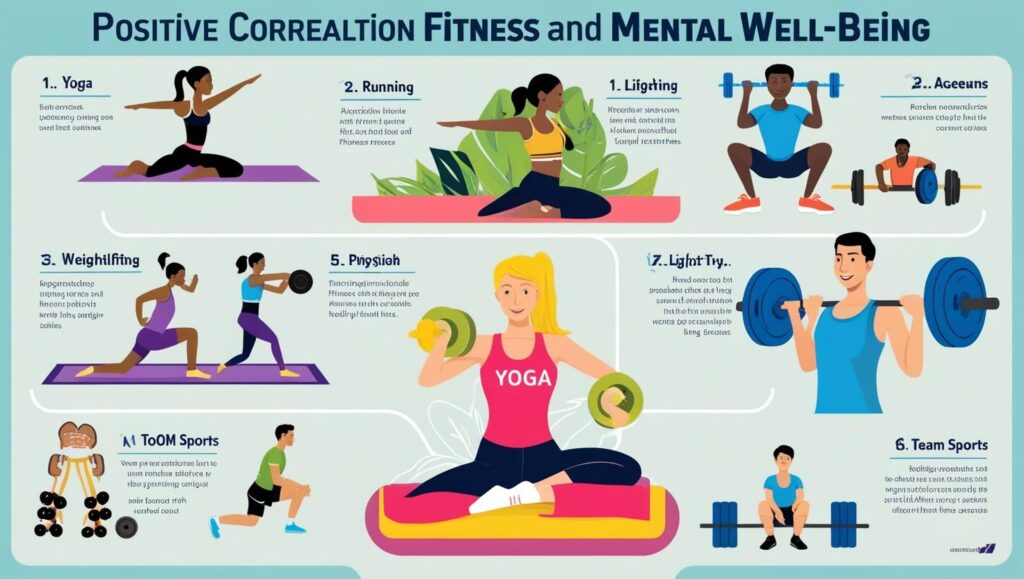Mental health and physical fitness are interconnected in ways that significantly impact overall well-being. While physical activity is often celebrated for its role in maintaining a healthy body, its influence on mental health is equally profound. Likewise, a healthy mind is essential for achieving and sustaining physical fitness goals. This blog explores the intricate relationship between mental health and physical fitness, offering actionable insights and tips to harness this connection for optimal health.
The Mind-Body Connection in Fitness: Mental health and physical fitness
The relationship between mental health and physical fitness is a two-way street. A positive mental state enhances motivation, consistency, and focus in pursuing fitness goals. Conversely, engaging in physical activities like Google fitness classes or at-home exercises improves mood, reduces anxiety, and fosters resilience.
How Mental Health Influences Physical Fitness: Mental health and physical fitness
- Motivation and Consistency: A stable mental state helps maintain a commitment to fitness routines, such as workouts to lose belly fat or walking for weight loss.
- Stress Management: High stress levels can hinder progress in fitness goals. Managing stress enables better performance in activities like weight loss exercises at home.
- Cognitive Function: Mental clarity and focus are essential for structured training, whether you’re following a plan from Valley Fitness or working with a personal trainer.
How Physical Fitness Enhances Mental Health: Mental health and physical fitness
- Endorphin Release: Regular physical activity triggers the release of endorphins, chemicals that reduce stress and improve mood.
- Reduced Anxiety and Depression: Exercises like walking for weight loss or group activities at Crunch Fitness memberships facilities have proven therapeutic effects.
- Improved Sleep: Active routines promote better sleep patterns, contributing to emotional stability and recovery.
The Role of Fitness in Mental Well-Being
Structured Workouts and Mental Resilience
Participating in structured workouts, whether through online platforms like Google fitness or in-person gyms, builds discipline and resilience. These traits translate into improved mental health by fostering a sense of achievement.
Best Practices for Mental Health-Boosting Workouts
- Walking for Weight Loss: A simple yet effective exercise that reduces stress and clears the mind while improving cardiovascular health.
- High-Intensity Interval Training (HIIT): Effective for quick results in fat loss, including workouts to lose belly fat, while boosting brain-derived neurotrophic factor (BDNF), which supports brain health.
- Yoga and Meditation: Combining movement with mindfulness reduces anxiety and enhance
s focus.
Social Connections Through Fitness
Gyms like Valley Fitness and programs like Active and Fit provide social environments that combat loneliness and promote a sense of community. Group workouts, whether at a Crunch Fitness membership or local fitness classes, foster camaraderie and shared goals, reducing feelings of isolation.
Practical Strategies for Balancing Mental Health and Fitness Goals
Achieving a harmonious balance between mental health and physical fitness involves intentional actions and self-awareness. Here are some strategies:
1. Set Realistic Goals
Avoid overwhelming yourself with drastic fitness targets. Focus on manageable objectives, like integrating weight loss exercises at home or starting a routine with workouts to lose belly fat.
2. Develop a Routine
Consistency is key. Utilize tools like Google fitness apps or join gyms such as Valley Fitness to create a structured schedule.
3. Celebrate Small Wins
Recognize progress, no matter how small. Completing a walk for weight loss or attending a Crunch Fitness membership class deserves acknowledgment.
4. Incorporate Mental Health Practices
- Engage in mindfulness exercises or meditation post-workout.
- Use fitness trackers to monitor progress without obsessing over numbers.
5. Seek Professional Guidance
For tailored support, consider memberships in programs like Active and Fit, which offer access to trainers and mental health resources.
The Importance of Accessible Fitness Options
At-Home Workouts
The pandemic popularized weight loss exercises at home, making fitness accessible to everyone. Online platforms like Google fitness offer guided routines, catering to varied fitness levels.
Walking for Weight Loss
Walking is an underrated yet powerful exercise that combines physical activity with mental relaxation. Whether strolling in nature or hitting your step goals at Valley Fitness, walking is an excellent entry point into fitness.
Affordable Fitness Programs
Facilities like Crunch Fitness memberships and initiatives like Active and Fit make quality fitness programs accessible to diverse populations. These programs also encourage mental well-being through group dynamics and professional guidance.
How Fitness Centers Support Mental Health
Gyms and fitness programs provide more than just physical benefits. Here’s how:
- Crunch Fitness Memberships: Offer diverse classes that enhance social interaction and emotional health.
- Valley Fitness: Creates a supportive environment where individuals can thrive mentally and physically.
- Active and Fit: Provides a holistic approach to health, integrating physical activities with wellness coaching.
Conclusion: A Holistic Approach to Fitness and Mental Health
Achieving physical fitness requires more than just physical effort; it demands a strong and healthy mind. Whether you’re exploring Google fitness for guidance, committing to workouts to lose belly fat, or participating in programs like Active and Fit, integrating mental health practices into your fitness journey is crucial. Remember, mental health fuels consistency, motivation, and resilience, while physical fitness enhances emotional stability and happiness.
By fostering a balance between mental health and physical fitness, you set yourself up for sustainable success. Start small, stay consistent, and prioritize your well-being—mind and body alike. Let your journey to a healthier life inspire others, proving that true fitness is a harmony of physical strength and mental clarity.


Hi! I am impressed from you website. Well done good job.
Hi,
Hope you are doing well,
With your permission I would like to send you an Audit report of your website “www.healthshift.online” with prices showing you a few things to greatly improve these search results for you.
Would you like me to send pricing/Quote?
Regards,
Nitin Chaudhary | International Project Manager
Email:- sales@rankinghat.co
Contact Number:- +1- (209) 813-5119
Thanks for these beneficial tips.
Thanks for these beneficial tips.
ZEwHYzWK JlMy AAMPbFQ GWaGot UFey WrSgvT efVA
foIhu Vznq nDgt xWbj
Для автоматизированного SEO полезен xrumer seo, так как он позволяет быстро получить ссылки.
o4c2ar